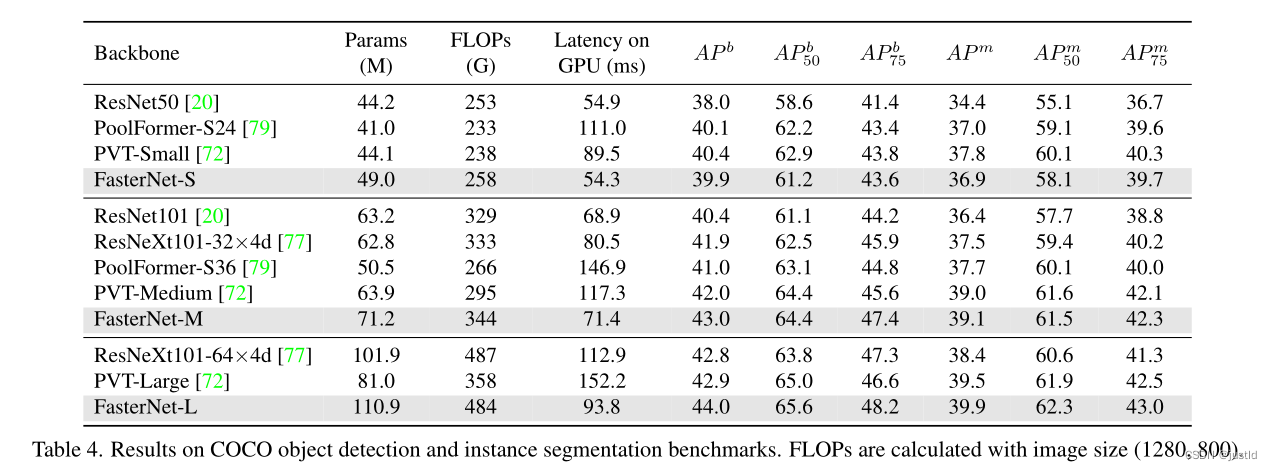本文主要是介绍【论文笔记】Run, Don’t Walk: Chasing Higher FLOPS for Faster Neural Networks,希望对大家解决编程问题提供一定的参考价值,需要的开发者们随着小编来一起学习吧!
论文地址:Run, Don't Walk: Chasing Higher FLOPS for Faster Neural Networks
代码地址:https://github.com/jierunchen/fasternet
该论文主要提出了PConv,通过优化FLOPS提出了快速推理模型FasterNet。
在设计神经网络结构的时候,大部分注意力都会放在降低FLOPs( floating-point opera-
tions)上,有的时候FLOPs降低了,并不意味了推理速度加快了,这主要是因为没考虑到FLOPS(floating-point operations per second)。针对该问题,作者提出了PConv( partial convolution),通过提高FLOPS来加快推理速度。
一、引言
非常多的实时推理模型都将重点放在降低FLOPs上,比如:MobileNet,ShuffleNet,GhostNet等等。虽然这些网络都降低了FLOPs,但是他们没有考虑到FLOPS,所以推理速度仍有优化空间,推理的延时计算公式如下:

由上式可以看出,要想加快推理速度,不仅可以从FLOPs入手,也可以优化FLOPS。作者在多个模型上做了实验,发现很多模型的FLOPS低于ResNet50。于是作者提出了PConv,通过提高FLOPS来加快推理速度。

二、PConv
为了提高FLOPS,作者提出了PConv,其结构如下图:

部分通道数经过卷积运算,其他通道不进行运算。再看了几眼。。。。这个和GhostConv好像呀。。。。
网络整体结构如下:

三、模型性能
FasterNet在ImageNet-1K上的表现如下:

在coco数据集上的表现如下:

四、代码
给出PConv的代码,也是非常简单:
# Copyright (c) Microsoft Corporation.
# Licensed under the MIT License.
import torch
import torch.nn as nn
from timm.models.layers import DropPath, to_2tuple, trunc_normal_
from functools import partial
from typing import List
from torch import Tensor
import copy
import ostry:from mmdet.models.builder import BACKBONES as det_BACKBONESfrom mmdet.utils import get_root_loggerfrom mmcv.runner import _load_checkpointhas_mmdet = True
except ImportError:print("If for detection, please install mmdetection first")has_mmdet = Falseclass Partial_conv3(nn.Module):def __init__(self, dim, n_div, forward):super().__init__()self.dim_conv3 = dim // n_divself.dim_untouched = dim - self.dim_conv3self.partial_conv3 = nn.Conv2d(self.dim_conv3, self.dim_conv3, 3, 1, 1, bias=False)if forward == 'slicing':self.forward = self.forward_slicingelif forward == 'split_cat':self.forward = self.forward_split_catelse:raise NotImplementedErrordef forward_slicing(self, x: Tensor) -> Tensor:# only for inferencex = x.clone() # !!! Keep the original input intact for the residual connection laterx[:, :self.dim_conv3, :, :] = self.partial_conv3(x[:, :self.dim_conv3, :, :])return xdef forward_split_cat(self, x: Tensor) -> Tensor:# for training/inferencex1, x2 = torch.split(x, [self.dim_conv3, self.dim_untouched], dim=1)x1 = self.partial_conv3(x1)x = torch.cat((x1, x2), 1)return xclass MLPBlock(nn.Module):def __init__(self,dim,n_div,mlp_ratio,drop_path,layer_scale_init_value,act_layer,norm_layer,pconv_fw_type):super().__init__()self.dim = dimself.mlp_ratio = mlp_ratioself.drop_path = DropPath(drop_path) if drop_path > 0. else nn.Identity()self.n_div = n_divmlp_hidden_dim = int(dim * mlp_ratio)mlp_layer: List[nn.Module] = [nn.Conv2d(dim, mlp_hidden_dim, 1, bias=False),norm_layer(mlp_hidden_dim),act_layer(),nn.Conv2d(mlp_hidden_dim, dim, 1, bias=False)]self.mlp = nn.Sequential(*mlp_layer)self.spatial_mixing = Partial_conv3(dim,n_div,pconv_fw_type)if layer_scale_init_value > 0:self.layer_scale = nn.Parameter(layer_scale_init_value * torch.ones((dim)), requires_grad=True)self.forward = self.forward_layer_scaleelse:self.forward = self.forwarddef forward(self, x: Tensor) -> Tensor:shortcut = xx = self.spatial_mixing(x)x = shortcut + self.drop_path(self.mlp(x))return xdef forward_layer_scale(self, x: Tensor) -> Tensor:shortcut = xx = self.spatial_mixing(x)x = shortcut + self.drop_path(self.layer_scale.unsqueeze(-1).unsqueeze(-1) * self.mlp(x))return xclass BasicStage(nn.Module):def __init__(self,dim,depth,n_div,mlp_ratio,drop_path,layer_scale_init_value,norm_layer,act_layer,pconv_fw_type):super().__init__()blocks_list = [MLPBlock(dim=dim,n_div=n_div,mlp_ratio=mlp_ratio,drop_path=drop_path[i],layer_scale_init_value=layer_scale_init_value,norm_layer=norm_layer,act_layer=act_layer,pconv_fw_type=pconv_fw_type)for i in range(depth)]self.blocks = nn.Sequential(*blocks_list)def forward(self, x: Tensor) -> Tensor:x = self.blocks(x)return xclass PatchEmbed(nn.Module):def __init__(self, patch_size, patch_stride, in_chans, embed_dim, norm_layer):super().__init__()self.proj = nn.Conv2d(in_chans, embed_dim, kernel_size=patch_size, stride=patch_stride, bias=False)if norm_layer is not None:self.norm = norm_layer(embed_dim)else:self.norm = nn.Identity()def forward(self, x: Tensor) -> Tensor:x = self.norm(self.proj(x))return xclass PatchMerging(nn.Module):def __init__(self, patch_size2, patch_stride2, dim, norm_layer):super().__init__()self.reduction = nn.Conv2d(dim, 2 * dim, kernel_size=patch_size2, stride=patch_stride2, bias=False)if norm_layer is not None:self.norm = norm_layer(2 * dim)else:self.norm = nn.Identity()def forward(self, x: Tensor) -> Tensor:x = self.norm(self.reduction(x))return xclass FasterNet(nn.Module):def __init__(self,in_chans=3,num_classes=1000,embed_dim=96,depths=(1, 2, 8, 2),mlp_ratio=2.,n_div=4,patch_size=4,patch_stride=4,patch_size2=2, # for subsequent layerspatch_stride2=2,patch_norm=True,feature_dim=1280,drop_path_rate=0.1,layer_scale_init_value=0,norm_layer='BN',act_layer='RELU',fork_feat=False,init_cfg=None,pretrained=None,pconv_fw_type='split_cat',**kwargs):super().__init__()if norm_layer == 'BN':norm_layer = nn.BatchNorm2delse:raise NotImplementedErrorif act_layer == 'GELU':act_layer = nn.GELUelif act_layer == 'RELU':act_layer = partial(nn.ReLU, inplace=True)else:raise NotImplementedErrorif not fork_feat:self.num_classes = num_classesself.num_stages = len(depths)self.embed_dim = embed_dimself.patch_norm = patch_normself.num_features = int(embed_dim * 2 ** (self.num_stages - 1))self.mlp_ratio = mlp_ratioself.depths = depths# split image into non-overlapping patchesself.patch_embed = PatchEmbed(patch_size=patch_size,patch_stride=patch_stride,in_chans=in_chans,embed_dim=embed_dim,norm_layer=norm_layer if self.patch_norm else None)# stochastic depth decay ruledpr = [x.item()for x in torch.linspace(0, drop_path_rate, sum(depths))]# build layersstages_list = []for i_stage in range(self.num_stages):stage = BasicStage(dim=int(embed_dim * 2 ** i_stage),n_div=n_div,depth=depths[i_stage],mlp_ratio=self.mlp_ratio,drop_path=dpr[sum(depths[:i_stage]):sum(depths[:i_stage + 1])],layer_scale_init_value=layer_scale_init_value,norm_layer=norm_layer,act_layer=act_layer,pconv_fw_type=pconv_fw_type)stages_list.append(stage)# patch merging layerif i_stage < self.num_stages - 1:stages_list.append(PatchMerging(patch_size2=patch_size2,patch_stride2=patch_stride2,dim=int(embed_dim * 2 ** i_stage),norm_layer=norm_layer))self.stages = nn.Sequential(*stages_list)self.fork_feat = fork_featif self.fork_feat:self.forward = self.forward_det# add a norm layer for each outputself.out_indices = [0, 2, 4, 6]for i_emb, i_layer in enumerate(self.out_indices):if i_emb == 0 and os.environ.get('FORK_LAST3', None):raise NotImplementedErrorelse:layer = norm_layer(int(embed_dim * 2 ** i_emb))layer_name = f'norm{i_layer}'self.add_module(layer_name, layer)else:self.forward = self.forward_cls# Classifier headself.avgpool_pre_head = nn.Sequential(nn.AdaptiveAvgPool2d(1),nn.Conv2d(self.num_features, feature_dim, 1, bias=False),act_layer())self.head = nn.Linear(feature_dim, num_classes) \if num_classes > 0 else nn.Identity()self.apply(self.cls_init_weights)self.init_cfg = copy.deepcopy(init_cfg)if self.fork_feat and (self.init_cfg is not None or pretrained is not None):self.init_weights()def cls_init_weights(self, m):if isinstance(m, nn.Linear):trunc_normal_(m.weight, std=.02)if isinstance(m, nn.Linear) and m.bias is not None:nn.init.constant_(m.bias, 0)elif isinstance(m, (nn.Conv1d, nn.Conv2d)):trunc_normal_(m.weight, std=.02)if m.bias is not None:nn.init.constant_(m.bias, 0)elif isinstance(m, (nn.LayerNorm, nn.GroupNorm)):nn.init.constant_(m.bias, 0)nn.init.constant_(m.weight, 1.0)# init for mmdetection by loading imagenet pre-trained weightsdef init_weights(self, pretrained=None):logger = get_root_logger()if self.init_cfg is None and pretrained is None:logger.warn(f'No pre-trained weights for 'f'{self.__class__.__name__}, 'f'training start from scratch')passelse:assert 'checkpoint' in self.init_cfg, f'Only support ' \f'specify `Pretrained` in ' \f'`init_cfg` in ' \f'{self.__class__.__name__} 'if self.init_cfg is not None:ckpt_path = self.init_cfg['checkpoint']elif pretrained is not None:ckpt_path = pretrainedckpt = _load_checkpoint(ckpt_path, logger=logger, map_location='cpu')if 'state_dict' in ckpt:_state_dict = ckpt['state_dict']elif 'model' in ckpt:_state_dict = ckpt['model']else:_state_dict = ckptstate_dict = _state_dictmissing_keys, unexpected_keys = \self.load_state_dict(state_dict, False)# show for debugprint('missing_keys: ', missing_keys)print('unexpected_keys: ', unexpected_keys)def forward_cls(self, x):# output only the features of last layer for image classificationx = self.patch_embed(x)x = self.stages(x)x = self.avgpool_pre_head(x) # B C 1 1x = torch.flatten(x, 1)x = self.head(x)return xdef forward_det(self, x: Tensor) -> Tensor:# output the features of four stages for dense predictionx = self.patch_embed(x)outs = []for idx, stage in enumerate(self.stages):x = stage(x)if self.fork_feat and idx in self.out_indices:norm_layer = getattr(self, f'norm{idx}')x_out = norm_layer(x)outs.append(x_out)return outs这篇关于【论文笔记】Run, Don’t Walk: Chasing Higher FLOPS for Faster Neural Networks的文章就介绍到这儿,希望我们推荐的文章对编程师们有所帮助!






